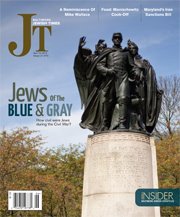By Yonatan Grossman-Boder (Baltimore Jewish Times, 4/13/2012)
 Passover was just around the corner that spring in 1862 when J.A. Joel, like so many other Jews, sought fixings for his seder. But it was a little harder for Joel, who was stationed at Sewell Mountain in eastern Fayette County, W.Va., with the Union’s 23rd Ohio Infantry.
Passover was just around the corner that spring in 1862 when J.A. Joel, like so many other Jews, sought fixings for his seder. But it was a little harder for Joel, who was stationed at Sewell Mountain in eastern Fayette County, W.Va., with the Union’s 23rd Ohio Infantry.
Joel turned to his fellow Jews in the regiment — 20 in all — to acquire the necessary items. With some foraging, the group found eggs, chickens and cider. Also, the group members procured matzoh and haggadot from their Jewish regimental merchant.
Unfortunately, they could not find horseradish. However, Joel recounted they “found a weed, whose bitterness, I apprehend, exceeded anything our forefathers ‘enjoyed.’” They also obtained a lamb. Though uncertain which part to use for the seder, Joel wrote that “Yankee ingenuity prevailed, and it was decided to cook the whole and put it on the table.”
With matzoh, egg, maror (bitter herbs), a shank bone and wine in hand, the men of the 23rd celebrated the Festival of Freedom in grand style. Joel was proud of their accomplishment and wrote to a local newspaper, “There, in the wild woods of West Virginia, away from home and friends, we consecrated and offered up to the ever-loving G-d of Israel our prayers and sacrifice.”
During the Civil War, J.A. Joel was one of approximately 10,000 Jews who fought in the armies of the Union and Confederacy. His story reminds us during this sesquicentennial anniversary of the Civil War that the history of the Jews in the United States is part of the larger story of American history.
Continue reading “Gray And Blue Jews Of The Civil War” at the Baltimore Jewish Times.

